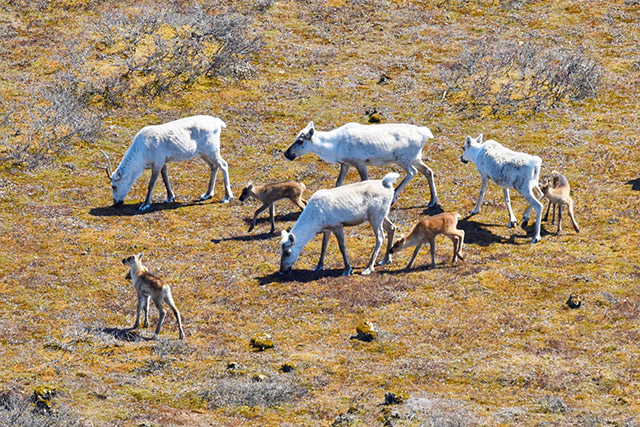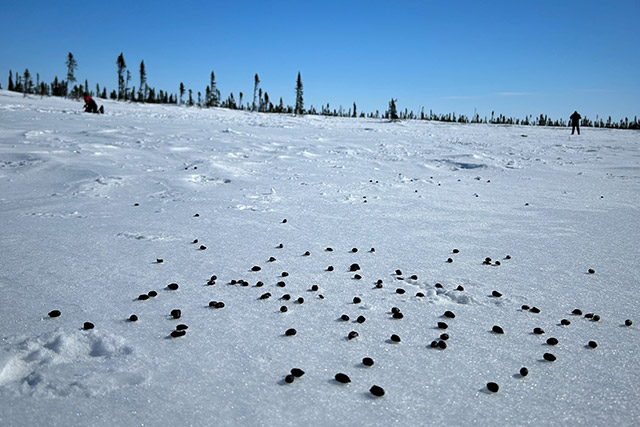Code Name: Shopping for Droppings: Cape Churchill Caribou Scat Collection
Wapusk National Park
The mystery: Caribou are known for their long migrations, with round-trip distances for some herds exceeding 745 km. Canada has twelve designatable units (DUs) of caribou which are broken down even further into herds that are differentiated by where their calving grounds are located. While we know that caribou frequent Wapusk National Park, scientists want to know exactly the who’s who of caribou.

The detectives: Parks Canada is pleased to be working with the Manitoba Métis Federation, the University of Saskatchewan, the Government of Manitoba, Environment and Climate Change Canada and York Factory First Nation to help crack the case.
The suspects: Three herds from two different DUs of caribou are known to annually migrate through Wapusk, but the frequency and regularity of these herds in the park is still unknown.
The Cape Churchill herd, with numbers fluctuating between 1,000 and 3,000, is most found in the park. This herd is an eastern migratory caribou that splits its time between Wapusk’s southwestern boreal forests in the winter and migrates as far as 200 km to their calving grounds on the shores of the Hudson Bay in northern Manitoba in the summer.
The Qamanirhuaq herd is as large as 288,000 caribou but has a large territory which covers portions of Manitoba, Nunavut, Saskatchewan and Northwest Territories. This means that only a fraction of this herd make their way through Wapusk. This herd is a barren-ground caribou, and their calving grounds are located in Nunavut.

The Pen Island herd has a territory that covers northwestern Ontario and into northeastern Manitoba. Considered the largest aggregation of caribou in Ontario, this herd has been thought to possibly be a mixture of caribou subspecies as their behaviour matches that of barren-ground caribou but their outward appearance suggests they are woodland caribou. Their traditional calving ground lies near the northern-most border between Manitoba and Ontario.
The clues: Whether you call it scat, feces or excrement, there’s a hundred and one names for droppings, and trust us, we’ve used them all for this project. Caribou scat contains DNA which scientists can process and turn into usable data. This allows us to learn about the genetic diversity of the caribou that migrate through Wapusk, as well as determine if the caribou herds are intermingling. This will help us better understand the ecological and evolutionary patterns of caribou in the Greater Wapusk Ecosystem.
The scat samples will be sent to our colleagues at Environment And Climate Change Canada EcoGenomics group in Ottawa for DNA extraction and genetic sequencing. Once the scat is sent, the team will be able to determine what genetic tools will be used based on the samples available.

We can use this data alongside visual data from our Candid Caribou Trail Camera project to answer questions relevant to the conservation of local caribou.
The investigation: The research excursion, or investigation if you will, started with helicopter surveys where the team took to the skies looking for signs of caribous. These signs can be tracks, areas where caribous have dug through the snow to access lichen, or caribou craters, also known as cratering sites, formed when caribous have sat or laid down to rest.
Upon the identification of these sites, the helicopters landed to allow the team to don surgical gloves to begin collecting pellet samples. An individual can expect to collect 20 to 30 pellets each, which were stored in a cooler to keep them frozen until they could be sequenced in a lab.

The scat search doesn’t stop there! Parks Canada participates in other winter field work such as snowmobile trips to the park to sample snowpack, haul fuel and to complete other research and monitoring trips. This gives the team a chance to opportunistically collect caribou field samples in the future.
The Uniform: While most sleuths wear a fedora and a trench coat, these investigators bundled up in their winter best to brave the harsh Wapusk weather. Accessories included sunglasses to help with snow glare, plastic gloves to safely handle scat samples, and a reusable shopping bag to carry their clues.
Case status: Is the case closed? Not just yet! While the mystery is still afoot, we hope to be able to report back with findings soon.
Related links
- Day in the Life – Cracking the code with eDNA
- Environmental DNA helping Parks Canada establish...
- Love, Loss, and Raptors
- A Day in the Life – Goose Banding
- Pick of the Season: Blueberry Jam
- Pick of the Season: Cranberries
- Churchill is the Greatest: 3 more reasons Time Magazine was...
- Pick of the Season: Fireweed jelly
- Pick of the Season: Labrador Tea
- Pick of the Season: Snow goose
- Join the Pod: 5 facts about beluga whales in Manitoba
- She can dig it: Cultural Resource Management Advisor Sandra...
- Date modified :